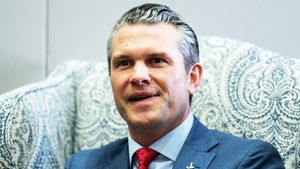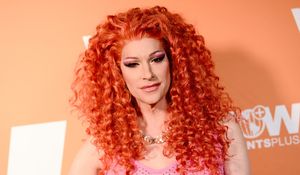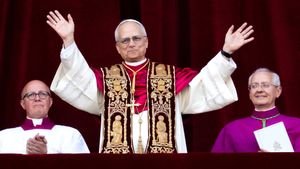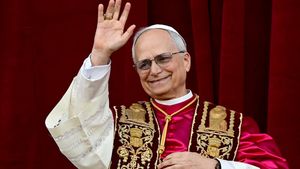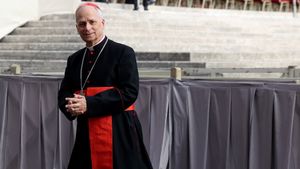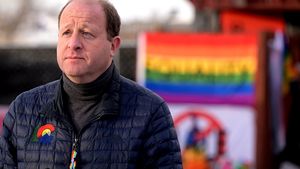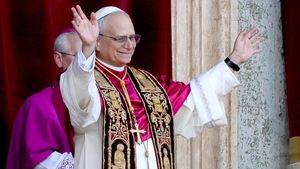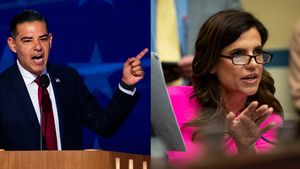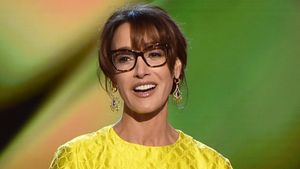That's a dumb idea, no one's gonna do that!" Dennis Peron took a deep hit on the fat joint that was being passed around his kitchen table on 17th Street and shook his head. "It's too complicated, and what's the point? And besides, nobody knows how to sew anymore."
Brownie Mary exhaled a small cloud of smoke. "I can sew." She'd already been arrested a couple times for her famous marijuana brownies but she still baked them and distributed them for free to the AIDS patients at San Francisco General Hospital. She and Peron, one of the most famous pot dealers in town, had both noticed that the weed calmed nausea and improved the appetite of patients who were very sick and dealing with the side effects of the harsh medications.
That was the reaction from pretty much everyone whenever I brought up my idea for a giant quilt bearing the names of people lost to AIDS. It was "too complicated." For over a year everyone told me it was the stupidest idea they'd ever heard of.
Brownie Mary was working with the Shanti Project now, a support group for people dying from AIDS and other terminal conditions.
Ruth Brinker lived a few blocks away. One of her neighbors was ill and too weak to shop for groceries or prepare meals. Ruth decided to help him and began to organize volunteers to shop and cook for the man, but some of the volunteers went on vacation and he died alone. Ruth was horrified and began cooking in earnest and was providing free nutritious meals to a growing list of desperately ill and often abandoned patients. Her one-woman operation soon grew into a giant meal delivery service for AIDS patients.
Almost everyone was involved one way or another. Some signed up with the "buddy" programs to visit the homebound and accompany patients to their medical appointments. Others worked to find housing, provide medical referrals, or offer legal advice or counseling.
I called up Bob Stemple one morning. We had remained friends since that first night he picked me up on Polk Street and gave me food and money. He was working for the City Clinic now on the new HIV antibody test program. I'd volunteered for a study and knew that my blood had been tested for HIV. It was time to get the results.
Bob met me at the Village Deli Cafe Keith Rice wasn't working that day and I was relieved, not wanting a witness if the news was bad. We ordered tuna on rye. Bob sipped his iced tea and asked me, "What do you think?"
I said, "I think I've got it."
"You're right."
I didn't realize how much hope I had harbored until I felt it drain away. Of course I was infected--how could I not be when so many of my friends and lovers had already died? Bob smiled gently and reached out to take my hand. I didn't cry. Not there, not yet.
Dr. Conant saw me a few days later. "How much time do I have left?" I asked him.
He laughed, "Don't be melodramatic, you're not even sick yet." But I knew it was a death sentence. I was 31 years old.
I could see it so clearly in my head and it was starting to make me crazy. All I had were words, and apparently the words I had were insufficient to paint for others the image in my brain: the National Mall, covered in fabric stretching from the Capitol to the Washington Monument. But whenever I began to talk about it, I was met with blank stares or rolling eyes.
Even the word had power for me. Quilts. It made me think of my grandmothers and great-grandmothers. It evoked images of pioneer women making camp by the Conestoga wagons. Or African slaves in the South, hoarding scraps of fabric from the master's house. It spoke of cast-offs, discarded remnants, different colors and textures, sewn together to create something beautiful and useful and warm. Comforters.
I imagined families sharing stories of their loved ones as they cut and sewed the fabric. It could be therapy, I hoped, for a community that was increasingly paralyzed by grief and rage and powerlessness.
It could be a tool for the media, to reveal the humanity behind the statistics. And a weapon to deploy against the government; to shame them with stark visual evidence of their utter failure to respond to the suffering and death that spread and increased with every passing day.
As I continued to work for the Friends Committee on Legislation, I couldn't shake the idea of a quilt. I traveled frequently throughout California to visit the local Quaker meetings that supported the FCL's work on criminal justice issues. One Sunday at the Palo Alto Friends Meeting I met a young man named Atticus who had just graduated from Stanford University. I could tell he hadn't been to a Quaker meeting before; he was wearing a jacket and tie while the Friends were more casual. He had a cold and I could tell he was embarrassed by the sound of his sniffles in the otherwise silent meetinghouse. I thought he was adorable.
We started to date. I decided that it was not fair to the Quakers for me to work with them while I became more and more distracted by the idea of the quilt. I'd saved some money and Atticus was well paid. We eventually got an apartment on Hancock Street near Dolores Park in San Francisco. It was a beautiful little apartment with spectacular views of downtown from the bay windows. Al and Mila Schneider, the landlords, lived next door. Al was Swiss, his wife came from the Philippines, and they liked us. Mila was especially fond of Atticus and would call out to him in the morning as he left for work, "Good morning, Atty-koos."
Atticus listened to my ideas for the Quilt and encouraged me. He also noted that I needed an administrative type, someone with managerial skills, to help me. He introduced me to a friend of his from Stanford named Mike Smith. Meanwhile, my friend Joseph and I started making quilt panels. The first was for Marvin; I painted it in the backyard. It wasn't very good, and I fear Marvin would have disapproved. He would have wanted something suitable for the Museum of Modern Art, or at least for a display window at Barneys on Madison Avenue. Joseph and I made a list of forty men we felt that we had known well enough to memorialize and began painting their names on 3-by-6-foot blocks of fabric. We both remembered that night on Castro Street and talking of how much land would be covered if the bodies of our dead were laid out head to toe. Each panel was the approximate size of a grave.
Mike and I called a meeting in the spring of 1987, rented a room in the Women's Building for a few hours, and put up posters around the neighborhood. Hardly anyone showed up, but two who did were Jack Caster and Cindy McMullen, who preferred to be called "Gert." Both had already created panels for their own friends, and they were far more elaborate and artistic than the crude first attempts that Joseph and I had painted in my backyard. Jack would volunteer for us until he died. Gert is still sewing.
For over a year, activists from around the country had been working to organize a mass march for lesbian and gay rights to be held in October 1987 in Washington, DC. I was determined to unfold the Quilt on the Mall at the march.
By June we had several dozen panels created. Some of them were quite plain; others were magnificently artistic. Gilbert Baker made a hot pink panel for Bobbi Campbell. Gert sewed them eight at a time into squares that were 12 by 12 feet, and edged them with canvas with evenly spaced grommets to enable the squares to be linked together or suspended.
As the annual Gay Freedom Day celebration approached, we asked Mayor Feinstein for permission to hang the first five squares from the mayor's balcony at City Hall, overlooking the main stage and Civic Center Plaza. To our surprise, she readily agreed.
We had a new Member of Congress representing San Francisco and I asked her for help with some trepidation, having campaigned for her opponent in the election, Harry Britt. Nancy Pelosi agreed to help, but she was skeptical. "Cleve, I actually know how to sew and enjoy it, but do you really think people will find the time to do this?"
She, Leo T. McCarthy, and Art Agnos hosted the first fundraiser at her posh home in Pacific Heights. The Castro Street Fair was organized as a nonprofit and we began to operate under their auspices. We had a name now: the NAMES Project AIDS Memorial Quilt.
Almost immediately we came up against two bureaucracies. The organizers of the national march didn't like the idea of us draping a couple blocks of the Mall with fabric, and neither did the National Park Service.
Nancy Pelosi met with the Park Service officials. They expressed concern that the fabric would kill the lawn. Pelosi told them we could "fluff" the Quilt every hour to let the grass breathe. It was an utterly ridiculous promise to make but the Park Service bought it and issued the permit.
Ken Jones and San Diego activist Nicole Murray-Ramirez helped persuade the march organizers to not oppose our presence.
On Sunday, June 28, 1987, over two hundred thousand attended the San Francisco Lesbian and Gay Freedom Day Parade and celebration. The day was dedicated to the memory of people who had died from AIDS. Everyone in Civic Center Plaza could see clearly the multicolored Quilt sections hanging from the mayor's balcony.
I finally had more than words to describe my vision. People could see it now. They lined up at our information booth up to talk with Mike and Gert and Jack and to get copies of our first brochure with instructions for creating memorial Quilt panels. Those brochures would travel back to the hometowns of all the visitors. Across America people began to sew.
We rented the cavernous old building at 2362 Market Street, where Harvey Milk had moved his Castro Camera store after being evicted from Castro Street back in 1978.
On October 11, 1987, the second National March on Washington for Gay and Lesbian Rights drew approximately five hundred thousand people. The first display of the NAMES Project AIDS Memorial Quilt was unfolded at dawn with 1,920 individual panels, just a small fraction of the more than twenty thousand Americans who had already lost their lives to AIDS. It took hundreds of volunteers, who came from all over the country to work with the core group of Mike Smith, Gert, Jack, Debra Resnik, Scott Lago, Leslie Ewinga, Rebecca LePere, and the many others who had walked away from careers and families to create the Quilt. Donald Montwell and Jim Maness flew in from Maui. Jim was near death and could no longer walk. They had worked with Whoopi Goldberg early in her career at the Valencia Rose. Before we opened the Quilt to the crowd, Whoopi, Jim, Donald, Mike Smith, and I pushed Jim in his chair to the center of the Quilt. Around us, tens of thousands waited in silence in the cold morning air. Whoopi was wearing one of her tour coats, and she wrapped it around Jim's skinny shoulders. As we wheeled him back, Donald began to give the coat back to Whoopi, but Jim clutched at it, grinned up at me, and said, "I'm going to be buried in this." I believe he was.
Later, Mike Smith and I stood on a cherry picker 20 feet above the ground and watched as hundreds of thousands of people walked the canvas walkway grid that contained the squares of quilt panels. Only the reading of the names and the sound of people weeping broke the silence around us. We were exhausted and overwhelmed by the beauty of the Quilt and the horror it represented. It was my 33rd birthday.
On the flight home a few days later out of National Airport, the jet flew over the Mall. I looked down from my window and saw that the Park Service bureaucrats had been right. Despite Representative Nancy Pelosi's assurances, the canvas walkways of the Quilt had left behind a haunting afterimage of the grid on the lawn within which the Quilt had been unfolded.
***
Related | Listen Up, Gays! Legendary Activist Cleve Jones Has Some Things You Need to Hear
When We Rise: My Life in the Movement is currently available from Hachette Books.











